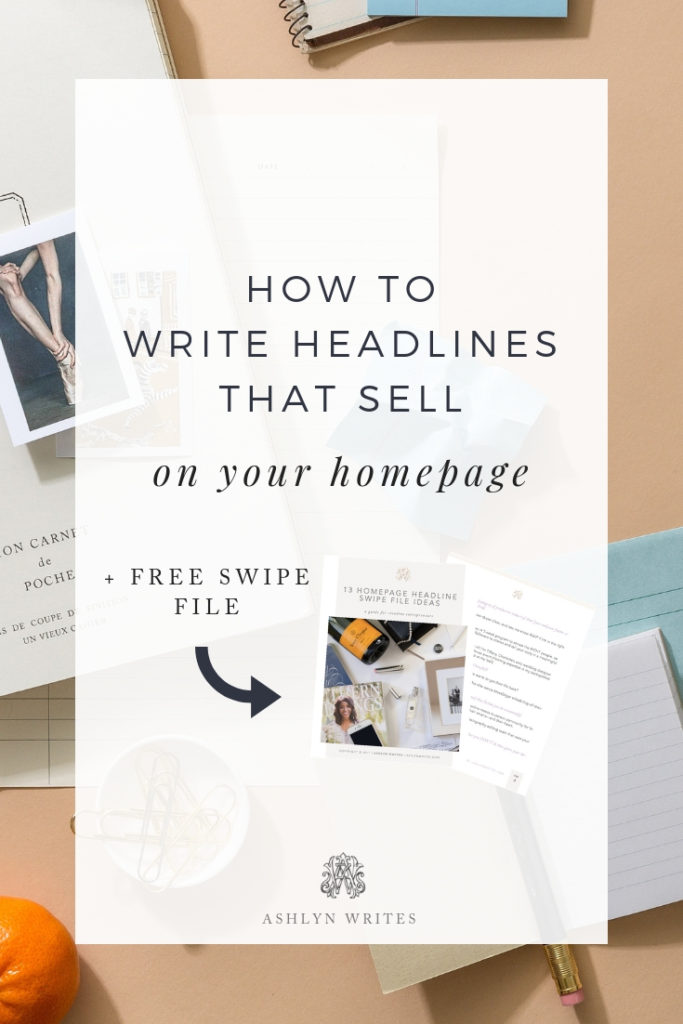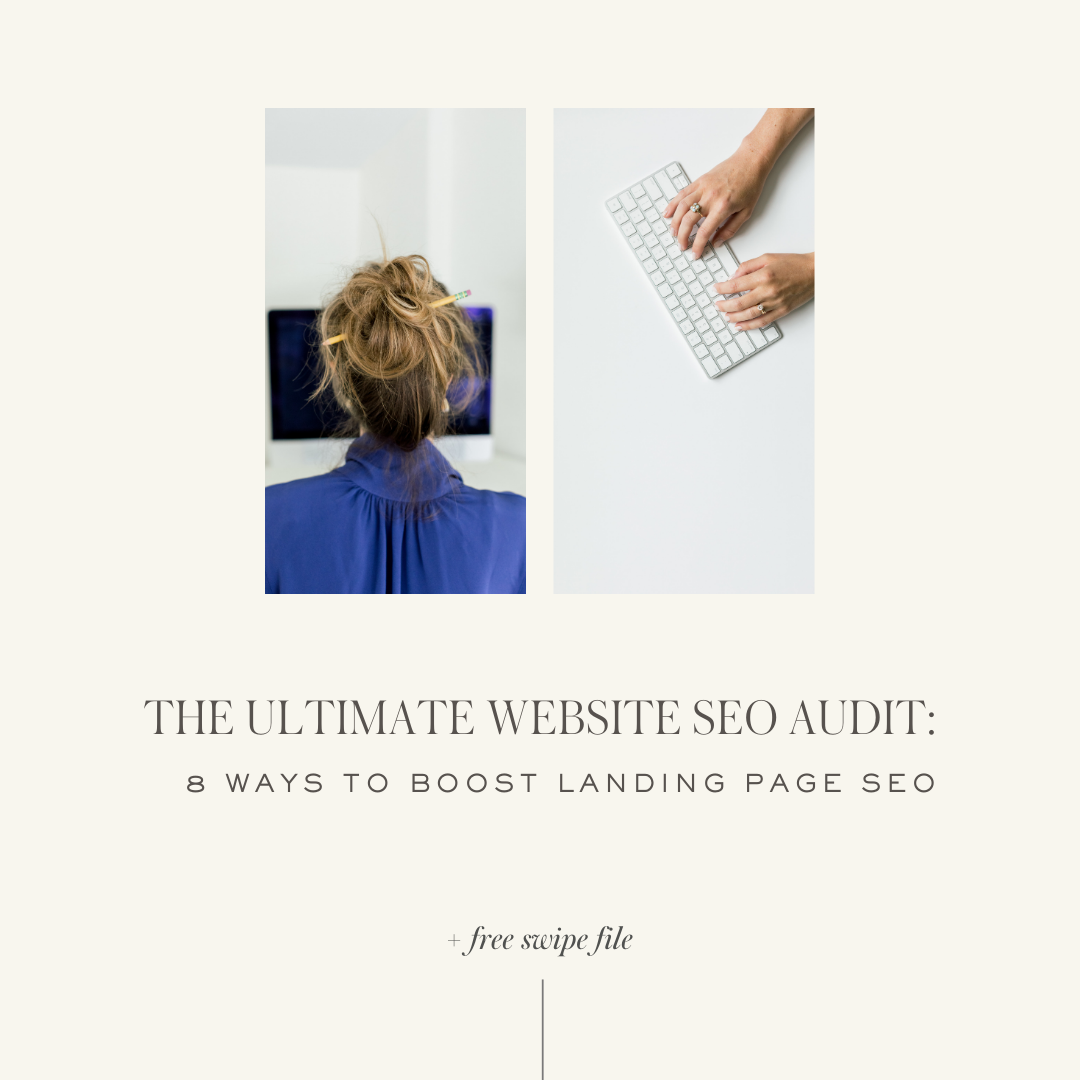Figuring out how to write headlines that sell (or subheadlines) for a homepage isn’t the easiest of tasks.
Today, we’re going to dig into some more helpful copywriting tools—last week, I posted a video of 5 mistakes you’re making on your website, asked for ideas of what to cover next, and this seemed like a great request! I’m sharing my 6 quick tests that your headlines on your website need to pass.

I mean, I do this every day, and I STILL save headlines for last when I’m drafting sales pages for my clients.
I also may or may not have walked away from my computer many a time to grab a shower, go on a walk/run, grab an evening glass of wine, etc. when I’ve been stuck on headline copy for a client’s website copy.
It’s tough.
Your headline’s gotta be an engaging snippet that shakes that hand of your target reader, and tells them to pull up a chair and sit a spell … while telling your non-ideal reader not to waste their time.
No pressure, right?
It’s maybe the most overused stat in online marketing, but it’s true, and someone out there needs to hear it:
“On the average, five times as many people read the headline as read the body copy. When you have written your headline, you have spent eighty cents out of your dollar.”
– David Ogilvy
Now, these are different from your blog post headlines—we’re talking about those headlines that pop up at the top of your website in that hero image section. So grab a pen, grab a coffee, and let’s get this party started.
[bctt tweet=”“On the average, five times as many people read the headline as read the body copy. When you have written your headline, you have spent eighty cents out of your dollar.” -David Ogilvy” username=”via AshlynSCarter”]
Ok, now that you’re feeling the heat about that homepage headline (sorry about that!), let’s chat about what to do to fix it!
Today, I’m going to tell you:
- Why this matters
- The 6 questions your headline must answer
- How to use 3 tools to generate headline ideas
When it comes to writing headlines, I have a procedure. Big surprise, if you follow me at all. And I LOVE a good formula to at least get me started. So, be sure to grab your freebie—13 headline swipes to get you started!
Why Writing Headlines that Sell on Your Homepage Matters
My dad would ask how many chances I get to make a first impression when I was little. “One!” I’d gleefully exclaim and beam after nailing his “trick” question.
More than two decades later, nothing’s changed for me—or you.

You still get ONE chance to hit that first point of true connection with your potential client.
This is the pivot point where they either feel 150% welcome … or where they feel awkward, out-of-place, or maybe even rejected.*
*It’s worth saying that there’s something to attracting/repelling, and you may want them to mosey on along because they’re not a fit … and that’s ok! I talk about that in the video above.
A good headline hooks your reader
No, having great headline copy isn’t a cure-all, but as a creative entrepreneur, you’ll usually do well to get in the weeds a bit and at least see if your headline can be part of the solution to some of the website conversion problems you may be having.
If no one can figure out what you do, and you’re tired of fielding questions? It may be time to clean up your homepage headline.
Your last Facebook ad campaign didn’t hit your goals? Time to check out your ad and landing page headlines.
So, for every page of your website and especially for your homepage, what.is.your.headline??? <– VIP question.
Six Questions Every Headline Must Answer
No intro here, I’m just gonna hop to it so you can get on your way in figuring out how to write headlines that sell. Let’s go!
1. Is it eye-catching?
You’ve fallen for a good, eye-catching headline before, right?
The people that have great headlines make them work because they’ve done the deep work to figure out what their voice is AND meld that with what their audience wants to hear. You can’t copycat! In order to build a brand you’ve got to find something different … copycatting or madlibbing a headline you’ve seen elsewhere (or that seems to be working for someone else in your niche) is obvious—it’s like wearing someone else’s outfit.
SO.
Remember that good marketing pulls—it doesn’t push.
For your homepage, you could try starting with an eye-catching question (ex. “Who else wants [desired end]?”) or your unique selling proposition (my students call it your “onlyness factor”): The Only [SEO keyword phrase] that [most desirable outcome]. Or maybe you want to tell them how to do something desirable in an unexpected way, like “Turn around your editing time faster with presets that actually work for you.”
Another thing you could do to catch eyes is weave in some tantalizing words.
Think “new,” “discover,” “introducing,” “announcing,” “it’s here,” “at last,” “how to,” “quick,” “last chance,” “proven,” or “just in.” (Oh yeah—beyond just your homepage, “free” is a good headline word too, because everyone loves free stuff! Use that when you can in your Facebook ads or content upgrade landing page headline copy).
I know writing words like this feels a *bit* offbeat for most creatives—and I know you don’t want to feel like a tabloid.
But.
These words pop up in copy because they work. Don’t focus so much on originality here that you miss the sale!222
2. Is it clear?
Clarity trumps cleverness … or cutsiness! Make sure the headlines on your homepage, about page, and beyond are around a 6th grade reading level–seriously! Nix the jargon, wordplay, puns, and cutesy copy. Make sure you answer your reader, sitting there wondering, “ok, but what’s in this for me?”
Clarity trumps cleverness … or cutsiness! Nix the jargon, wordplay, puns, and cutesy copy.

If you’ve been here since the beginning, you MIGHT have seen my very first website—complete with a bad headlines. It’s super embarrassing, looking back, but in bold words, I had my tagline copy: “stringing words, slinging ink.”
“A” for poetic device usage.
“F” for being clear on what in the world I did.
Be. Clear.
Make sure the headlines on your homepage, about page, and beyond are around a 6th-grade reading level–seriously! Make sure you answer your reader, sitting there wondering, “ok, but what’s in this for me?”
“Instead of clarifying speech or helping people communicate in a more efficient way, jargon just does the opposite.”
–Entrepreneur
3. Does it get to the point?
The key here? Your point IS NOT always your reader’s point.
Let’s say I sell essential oils. MY point is getting someone signed up for an essential oil starter kit that I *just know* will change her life. My reader’s point? It may be having a safer pregnancy, or feeling comfortable with a two-year-old crawling around near the chemicals under the sink.
Remember two little secrets here: first, people are selfish and secondly, readers are busy.
Before I write ANYTHING (from email newsletters to blog posts), I write down two things: What’s my goal, what’s my reader’s goal. My #1 tip? STUDY and test! I’m going to show you about testing in the next step!
Related: How to Cultivate a Blog Writing Workflow

4. Does it message-match?
You know when you’re thumbing through Instagram on the couch with Bravo on in the background, you click a free download or webinar ad, and next thing you know, you’re on some landing page that doesn’t sound anything like the headline you’d clicked through?
That’s due to a lack of something called message matching.
Whatever it is that’s pushing me to head to your website, I want to be affirmed in it the moment I land.
If people know your name as your brand, I want to see it when I land on your homepage.
If you are a Charlotte-based wedding designer, I want to know where you’re based quickly on your homepage.
Looking at the stats may not sound interesting to you, but sometimes it’s the headline you didn’t think at all that does the best. So, real quick, let’s take a look at an example that I mean.
LeadPages (click here to try Leadpages for 14 days risk-free!) is a GREAT software you can use to play around and test copy before putting it on your website somewhere else. Let me show you what I mean!
Click here to get started with LeadPages.
5. Does it highlight the benefit?
We decide with our emotions first, and our rationale secondly (listen to this great podcast from Think Creative Collective where my friend and sweet client Natalie Franke explains how our brains work in this regard!).
I get so excited about this, but one of the easiest things you can do is challenge your self to make a list of 100 benefits to whatever it is you’re selling. That way, even for the whole rest of the page, you know the built-in benefits that you’ve worked to figure out.
So, message-in the benefit that your reader wants in the headline … why does this even matter to them?
6. Does it draw them to the next line?
Finally, your headline has ONE job to do, and one job only: to get your reader to read the NEXT line of copy.
Which should make them read the next line …
And so on and so forth.
I would say this is one of the biggest things we forget when we’re writing copy for our websites.
Again, back to the example of client sales page copy I’m writing. Usually my goal? It’s to get them to scroll. It’s so easy to put a ton of pressure on this little piece of copy—your headline—to do more than hook the reader. So, really tap into how it can hook them and get them to read what’s next.
4 Go-to Headline Analyzers and Tools
As we wrap up, bookmark these headline tools so when figuring out how to write headlines that sell, you can move past blinking-cursor stage a bit faster. I know these four links are really suited for better BLOG headlines, but they’re great for how to write homepages that sell, too!
CoSchedule’s Headline Analyzer: Scores your SEO value, overall quality, and traffic expectations. Click here to get started with CoSchedule for 14 days free!
BlogAbout: Creates a fill-in-the-blank template on any topic you enter, so you can just refresh as many times as it takes to get a good one!
Portent’s Content Idea Generator: Similar to BlogAbout, but helps tell you the reasons why you should switch up certain headline ideas. I feel like this and BlogAbout are (obviously) best for blogs and not homepages, but still can be helpful!
CrazyEgg: My favorite heatmap tool (though Sumo is great, too!) so you can see what headlines capture your reader’s attention, and what make them scratch their head.
“Even the greatest writer can’t save an ad with a poor headline,” John Caples said, and it’s truth serum: no matter HOW studly the rest of your homepage’s copy, if your headline didn’t interest me, I’ve bounced.
I’d love to hear your a-ha moment during today’s video, share that in the comments below!
Reading Time: 8 Minutes Reading time: 8 min. Figuring out how to write headlines that sell (or subheadlines) for a homepage isn’t the easiest of tasks. Today, we’re going to dig into some more helpful copywriting tools—last week, I posted a video of 5 mistakes you’re making on your website, asked for ideas of what to cover next, and […]




comments +